Quanta Computer NL Notebook Computer User Manual NL1 User s Manual 1022
Quanta Computer Inc Notebook Computer NL1 User s Manual 1022
Contents
- 1. Manual 1
- 2. Manual 2
Manual 1
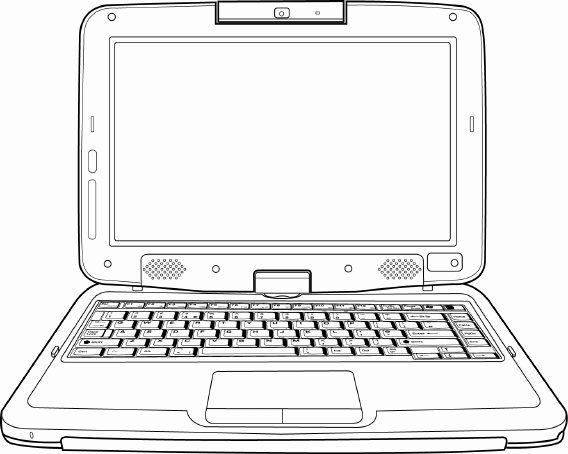
T
Th
hi
ir
rd
d
G
Ge
en
ne
er
ra
at
ti
io
on
n
I
In
nt
te
el
l
P
Po
ow
we
er
re
ed
d
C
Cl
la
as
ss
sm
ma
at
te
e
P
PC
C
User’s Manual
© Copyright 2008
All Rights Reserved.
The information in this document is subject to change without prior notice in
order to improve reliability, design and function and does not represent a
commitment on the part of the manufacturer.
In no event will the manufacturer be liable for direct, indirect, special, incidental,
or consequential damages arising out of the use or inability to use the product
or documentation, even if advised of the possibility of such damages.
This document contains proprietary information protected by copyright. All
rights are reserved. No part of this manual may be reproduced by any
mechanical, electronic, or other means in any form without prior written
permission of the manufacturer.
Limitation of Liability
While reasonable efforts have been made to ensure the accuracy of this manual,
the manufacturer and distributor assume no liability resulting from errors or
omissions in this manual, or from the use of the information contained herein.
i
C
Co
on
nt
te
en
nt
ts
s
Before You Start .........................................................................................1
Attention: Teachers and Parents.............................................................................1
For Your Safety ...........................................................................................................1
Caring for Your Notebook.......................................................................................2
Regulatory Information .............................................................................. 3
Federal Communications Commission Notice.....................................................3
Modifications................................................................................................................3
Connections to Peripheral Devices ........................................................................3
SAR Exposure..............................................................................................................4
Declaration of Conformity .......................................................................................4
European Notice.........................................................................................................4
Attachment Limitations Statement .........................................................................5
Power Cord Requirement ........................................................................................5
Battery Pack Safety.....................................................................................................6
Lithium battery warning / Bridge battery warning...............................................7
Touring the Notebook................................................................................ 9
Front..............................................................................................................................9
Left view .................................................................................................................... 10
Right view.................................................................................................................. 11
Back ............................................................................................................................12
Base............................................................................................................................. 13
Getting Started .........................................................................................14
Installing the Battery................................................................................................ 14
Charging the Battery............................................................................................... 15
Opening the LCD Panel ......................................................................................... 16
Switching the Power On ........................................................................................ 16
LED Status Indicators.............................................................................................. 18
ii
Using the Notebook..................................................................................19
Using the Keyboard................................................................................................. 19
Using the Touch Pad............................................................................................... 20
Using the Touch Screen ......................................................................................... 21
Rotating the Display Panel ..................................................................................... 21
Using the Web Camera.......................................................................................... 24
Conserving the Battery Power ............................................................................. 25
BIOS Setup ................................................................................................26
Entering BIOS Setup................................................................................................ 26
Main Setup................................................................................................................. 26
Advanced Setup........................................................................................................ 27
Security Setup........................................................................................................... 28
Boot Setup................................................................................................................. 29
Exit Setup................................................................................................................... 30
Troubleshooting ........................................................................................31
Specifications .............................................................................................32
Index ...........................................................................................................33
1
B
Be
ef
fo
or
re
e
Y
Yo
ou
u
S
St
ta
ar
rt
t
Attention: Teachers and Parents
This product is an educational tool designed for school age children, ages 6 and
up. Make sure that students understand this product is an educational tool and
not a toy.
Students must be supervised by an adult when using this notebook. Explain to
students the safe and proper handling of the notebook, power supply, battery
pack, and power cord.
Before students take the notebook home, instruct students to keep power
cords, small accessories, and loose parts away from younger children at all times.
Make sure students understand the warning label on the power cord. Emphasize
to students that any damage to the notebook or loose parts should be reported
immediately to a teacher or parent.
It is recommended that each session of use does not exceed thirty minutes, and
that students should take at least a five minute break between each use.
To ensure the notebook is in good working condition, periodically inspect the
notebook, power supply and power cord for damage, and replace if necessary.
For Your Safety
Before using in the classroom or home environment, make sure that students
understand the following precautions:
• Do not drop, crush, or step on the notebook.
• Do not place objects or apply heavy pressure on the notebook.
• Do not place on uneven or unstable work surfaces.
• Do not block the openings provided for ventilation, as overheating may
occur.
• Do not use or store the notebook in extreme weather conditions.
• Do not expose to sudden changes in temperature or humidity: keep the
notebook away from heating and A/C vents.
• Do not expose to magnetic fields.
• Do not expose to direct sunlight.
• Do not place near fire or other sources of heat.
2
• Do not expose to rain or moisture.
• Do not leave the notebook turned on or plugged in when enclosed in a non-
vented container, such as a backpack, as overheating may occur.
Caring for Your Notebook
• Do not spray water or any other cleaning fluids directly on the display.
• Do not clean the notebook when it is plugged into a wall socket.
• Make sure the notebook is turned off before cleaning, and clean with a
slightly damp cloth.
• When you are not using the notebook, keep the LCD panel closed to
protect the screen from dust.
• Make sure the touch pad does not come into contact with dirt, liquids, or
grease.
• Use the AC adapter whenever an AC wall outlet is available to prolong the
battery life and usage cycle.

3
R
Re
eg
gu
ul
la
at
to
or
ry
y
I
In
nf
fo
or
rm
ma
at
ti
io
on
n
Federal Communications Commission Notice
This equipment has been tested and found to comply with the limits for a Class
B digital device, pursuant to Part 15 of the FCC Rules. These limits are designed
to provide reasonable protection against harmful interference in a residential
installation. This equipment generates, uses, and can radiate radio frequency
energy and, if not installed and used in accordance with the instructions, may
cause harmful interference to radio communications. However, there is no
guarantee that interference will not occur in a particular installation. If this
equipment does cause harmful interference to radio or television reception,
which can be determined by turning the equipment off and on, the user is
encouraged to try to correct the interference by one or more of the following
measures:
• Reorient or relocate the receiving antenna.
• Increase the separation between the equipment and the receiver.
• Connect the equipment into an outlet on a circuit different from that to
which the receiver is connected.
• Consult the dealer or an experienced radio or television technician for help.
A
Warning
This transmitter must not be co-located or operating in conjunction with any
other antenna or transmitter.
Modifications
The FCC requires the user to be notified that any changes or modifications
made to this device that are not expressly approved by the Manufacturer may
void the user’s authority to operate the equipment.
Connections to Peripheral Devices
Connections to this device must be made with shielded cables with metallic
RFI/EMI connector hoods to maintain compliance with FCC Rules and
Regulations.
4
SAR Exposure
This device has been tested for compliance with FCC RF Exposure (SAR) limits
in typical flat configurations. In order to comply with SAR limits established in
the ANSI C95.1 standards, it is recommended when using a CF card that the
integrated antenna is positioned more than 1.5cm from your body or nearby
persons during extended periods of operation.
Declaration of Conformity
This device complies with Part 15 the FCC Rules. Operation is subject to the
following two conditions: (1) this device may not cause harmful interference, and
(2) this device must accept any interference received, including interference that
may cause undesired operation.
European Notice
Products with the CE Marking comply with both the EMC Directive
(2004/108/EC) and the Low Voltage Directive (2006/95/EC) and R&TTE
Directive (1999/5/EC) issued by the Commission of the European Community.
Compliance with these directives implies conformity to the following European
Norms:
• EN55022: 2006, CLASS B
• EN61000-3-2: 2006, CLASS D
• EN61000-3-3: 1995+A1: 2001+A2: 2005
• EN55024: 1998+A1: 2001+A2: 2003
• IEC61000-4-2: 2001 ED. 1.2
• IEC61000-4-3: 2006 ED. 3.0
• IEC61000-4-4: 2004 ED. 2.0
• IEC61000-4-5: 2005 ED. 2.0
• IEC61000-4-6: 2006 ED. 2.2
• IEC61000-4-8: 2001 ED. 1.1
• IEC61000-4-11: 2004 ED. 2.0
• EN 300 328-2, EN 300 328-1, EN 301 489-1, EN 301 489-17
(ETSI 300 328, ETSI 301 489) Electro-magnetic Compatibility and Radio
Spectrum Matter.

5
• TBR21 (ETSI TBR21) Terminal Equipment.
• EN60950 (IEC60950) I.T.E. Product Safety
Attachment Limitations Statement
Users should ensure for their own protection that the electrical ground
connections of the power utility, telephone lines and internal metallic water pipe
system, if present, are connected together. This precaution may be particularly
important in rural areas.
L
Caution
Users should not attempt to make such connections themselves, but should
contact the appropriate electric inspection authority, or electrician, as
appropriate.
Power Cord Requirement
The power cord supplied with the AC adapter should match the plug and
voltage requirements for your local area. Regulatory approval for the AC
adapter has been obtained using the power cord for the local area.
However, if you travel to a different area and need to connect to a different
outlet or voltage, you should use one of the power cords listed below. To
purchase a power cord (including one for a country not listed below) or a
replacement AC adapter, contact your local dealer.
U.S. and Canada
• The cord set must be UL/ETL-Listed and CSA-Certified or UL/C-ETL Listed.
• The minimum specifications for the flexible cord are (1) No. 18 AWG, (2)
Type SPT-2, and (3) 2-conductor.
• The cord set must have a rated current capacity of at least 7A.
• The attachment plug must be an earth-grounding type with a NEMA 1-15P
(7A, 125V) configuration.
Japan
• All components of the cord set (cord, connector, and plug) must bear a
“PSE” mark and registration number in accordance with the Japanese
Dentori Law.
• The minimum specifications for the flexible cord are: (1) 0.75 mm2
conductors, (2) Type VCT or VCTF, and (3) 3-conductor.
• The cord set must have minimum rated current capacity of 7 A.

6
• The attachment plug must be a two-pole, grounded type with a Japanese
Industrial Standard C8303 (15 A, 125 VAC) configuration.
Other Countries
• The cord set fittings must bear the certification mark of the agency
responsible for evaluation in a specific country.
Acceptable agencies are:
• CCC (China)
• The flexible cord must be of a HAR (harmonized) type HO5VVF 3-
conductor cord with a minimum conductor size of 0.03 square inches.
• The minimum specification for the flexible cord for Class II product are:
(1) 2X0.75 mm2 conductors, (2) 2-conductor cord.
• The cord set must have a current capacity of at least 10 A and a nominal
voltage rating of 125 / 250 VAC.
Note: This model IS DESIGNED TO USE WITH THE
FOLLOWING AC ADAPTER MODEL ONLY
Manufacture: LI SHIN INTERNATIONAL ENTERPRISE CORP.
Manufacture: Delta
Battery Pack Safety
• The battery pack is intended to use only with this notebook.
• The battery pack is not replaceable by the end user. Only qualified service
technicians should replace the battery pack.
• Do not disassemble the pack.
• Do not dispose of the battery pack in fire or water.
• To avoid risk of fire, burns, or damage to your battery pack, do not allow a
metal object to touch the battery contacts.
• Handle a damaged or leaking battery with extreme care. If you come in
contact with the electrolyte, wash the exposed area with soap and water. If
it contacts the eye, flush the eye with water for 15 minutes and seek medical
attention.
• Do not charge the battery pack if the ambient temperature exceeds 45°C
(113°F).

7
• To obtain a replacement battery, contact your local dealer.
• Do not expose the battery pack to high storage temperatures (above 60°C,
140°F).
• When discarding a battery pack, contact your local waste disposal provider
regarding local restrictions on the disposal or recycling of batteries.
• Use only supplied AC Adapter for charging.
Caution: Danger of explosion if battery is incorrectly replaced. Only
qualified service technicians should replace and discard the
battery pack. Replace only with same or equivalent type
recommended by the manufacturer. Discard used batteries
according to the manufacturer’s instructions or local laws.
Vorsicht: Explisionsgefahr bei unsachgernazen Austausch der Batterie.
Ersatz ur durch denselben oder einem vom Hersteller
empfohlenem ahnlichen Typ. Entsorgung gebrauchter
Batterien navh Angaben des Herstellers.
Lithium battery warning / Bridge battery
warning
This notebook contains a lithium battery to power the clock and calendar
circuitry.
Caution: Danger of explosion if battery is replaced incorrectly.
Replace only with the same or equivalent type
recommended by the manufacturer. Discard used batteries
according to the manufacturer’s instructions.
Note: Il y a danger d’xplosion s’il y a remplacement incorrect de la
batterie. Remplacer uniquement avcc unc batterie du meme
type ou d’un type recommande par le constructer. Mettre
au rebut les batteries usages conformement aux instructions
du fabricant.
Vorsicht: Explosionsgefahr bei unsachgemBen Austausch der Batterie
Ersatz nur durch denselben oder einem vom Hersteller
empfohlenem ahnlichen Typ. Entsorgung gebrauchter
Batterien nach Angaben des Herstellers.

8
Der Arbeitsplatzbezogene Schalldruckpegel nach DIN 45 635 betragt 70dB (A)
oder weniger.
Zum Netzanschlua dieses Gerates ist eine geprufte Leitung zu verwenden. Fur
einen Nennstrom bis 6A und einem Gerategewicht groBer 3kg ist eine Leitung
nicht leichter als (1) H05VV-F, 3G, 0.75mm2 (2) 2X0.75 mm2 conductors
einzusetzen.
Die Steckdose muB nahe dem Gerat angebracht und leicht zuganglich sein.
Caution: This part is hot. Be careful.
Vorsicht: Diese Flachewird sehr heiss.
When you see this symbol, be careful as this spot may be very hot. The heat is
generated from the CPU.
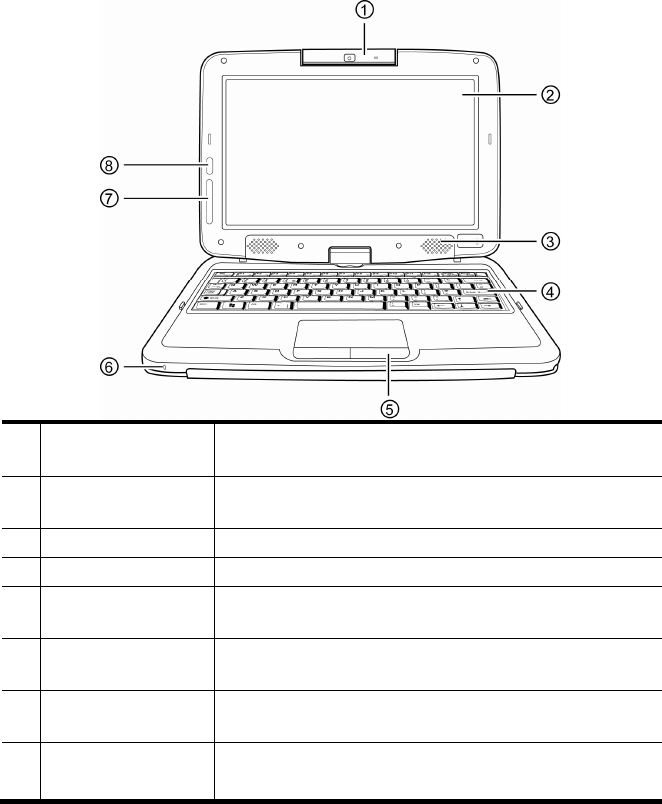
9
T
To
ou
ur
ri
in
ng
g
t
th
he
e
N
No
ot
te
eb
bo
oo
ok
k
µ Front
1. Built-in web
camera Use the built-in web camera for video conferencing.
2. LCD display Contents of the current system operation are
displayed here.
3. Stereo speakers The stereo speakers allow for audio output.
4. Keyboard Use the keyboard to enter data.
5. Touch pad Use the touch pad and two buttons as a mouse. See
“Using The Touch Pad”.
6. Microphone The built-in microphone allows the notebook to
receive audio input.
7. LED status
indicators
The operation status of your notebook is displayed
here. See “System Status Indicators”.
8. Bezel button Press to enter Quick Launcher.
Press twice to enter Quick Control Panel.
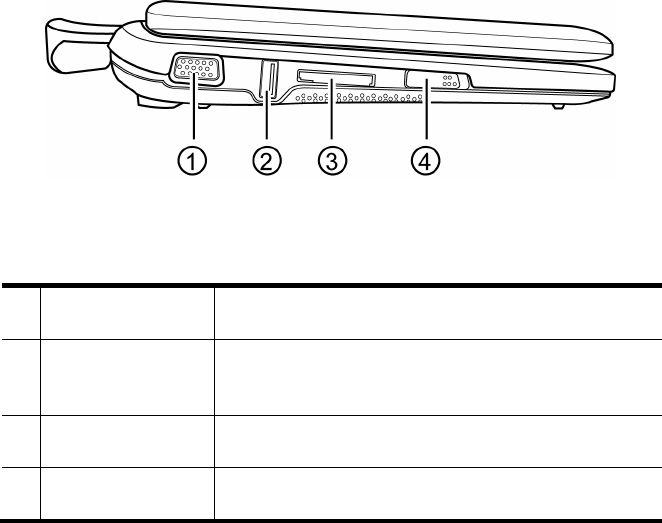
10
µ Left view
1. External monitor
port Use this port to connect to an external monitor.
2. USB port
Use this port to connect Universal Serial Bus
devices. The notebook supports v.2.0 of the USB
standard.
3. Memory card slot Insert a memory card into this slot to read the
stored data on the notebook.
4. Power latch Use this latch to turn your notebook on and off.
See “Switching the Power On”.
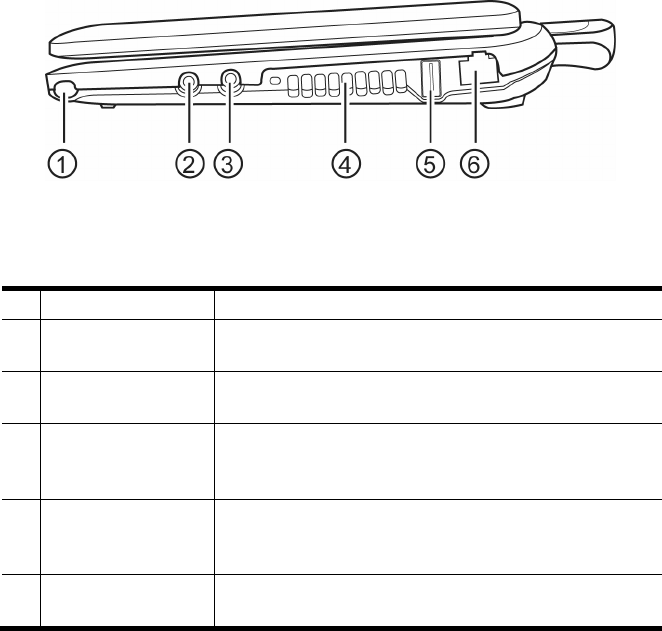
11
µ Right view
1. Stylus pen slot The stylus pen for the touch screen is stored here.
2. Microphone jack Use the microphone jack to connect an external
microphone.
3. Headphone jack Use the headphone jack to connect an external
headphone set.
4. Ventilation
opening
The ventilation opening allows the notebook to
cool off and prevent overheating. Do not block this
opening when the notebook is turned on.
5. USB port
Use this port to connect Universal Serial Bus
devices. The notebook supports v.2.0 of the USB
standard.
6. LAN (RJ-45) port Use this port to connect a standard RJ-45 plug of a
router or ADSL modem.
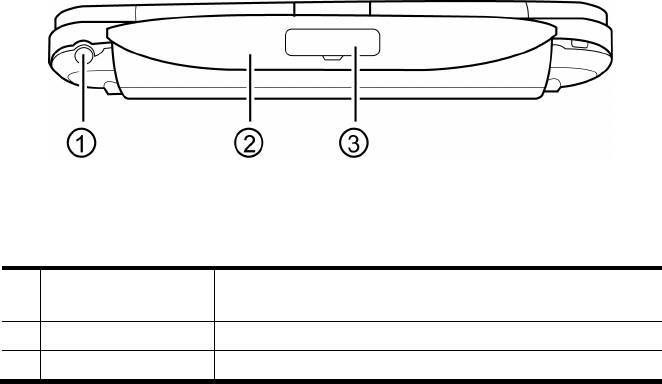
12
µ Back
1. Power adapter
port
Connect your AC adapter to this port to power up
your notebook and charge the battery pack.
2. Handle Use the handle to carry the notebook.
3. Name field Place your name tag here.
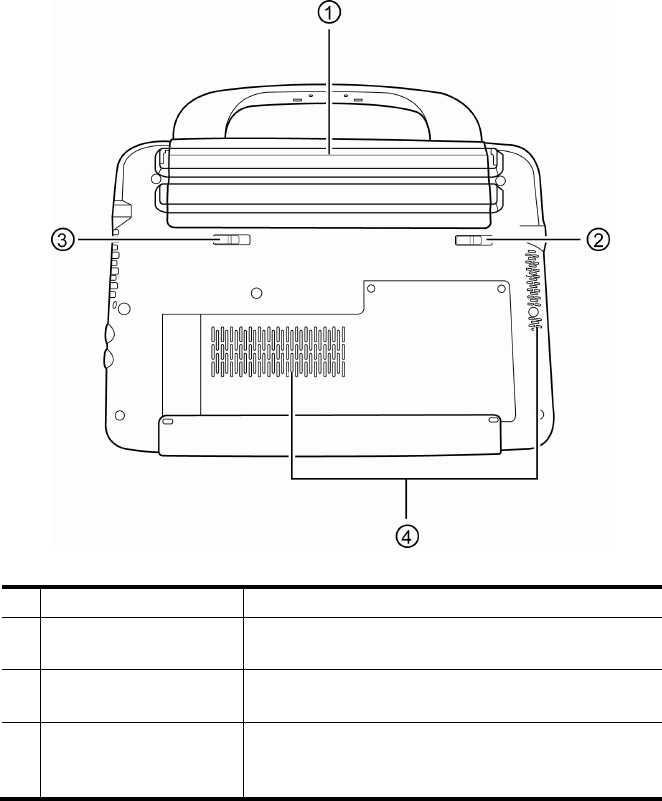
13
µ Base
1. Battery bay The battery pack is stored here.
2. Battery lock switch Use the battery lock switch to lock the battery
pack in the battery bay.
3. Battery release latch Use the battery release latch to release the
battery pack from the battery bay.
4. Ventilation openings
The ventilation openings allow the notebook to
cool off and prevent overheating. Do not block
these openings when the notebook is turned on.
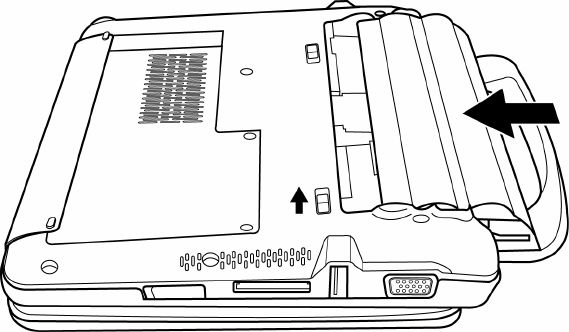
14
G
Ge
et
tt
ti
in
ng
g
S
St
ta
ar
rt
te
ed
d
Congratulations on your purchase of the third generation Intel powered
Classmate PC. Your notebook features a built-in web camera, rotating LCD
display panel, and touch screen functions. In this section, you will be introduced
to the basic operations of your notebook.
Installing the Battery
To install the battery pack:
1. Make sure the notebook is turned off.
2. Align and insert the battery pack into the battery bay. The end of the
battery pack ridge should align with the dip on the sides of the battery bay.
3. Slide the battery pack down gently but firmly until it locks into place.
4. Slide the battery lock switch left into the locked position.

15
To remove the battery pack:
1. Make sure the notebook is turned off.
2. Slide the battery lock switch left into the unlocked position.
3. Slide and hold the battery release latch, and slide the battery pack up.
4. Align the end of the battery pack ridge with the dip on the sides of the
battery bay.
5. Lift and remove the battery.
Note
You must charge the battery pack for at least six hours before using it for the
first time.
Charging the Battery
To charge the battery, plug the AC adaptor into the notebook and an electrical
outlet. Whenever possible, use the AC adaptor to keep the notebook
connected to a power source.
For a totally discharged battery, it will take approximately two hours to charge
to 90% capacity, and approximately three hours to 100% while the notebook is
powered off. It will take about five hours to charge the battery to 100% capacity
while the notebook is powered on.
If the system runs at heavy loads or in a high temperature environment, the
battery may not be fully charged. You need to continue to charge it with the AC
adaptor plugged in until the charging LED turns green.
• Low battery warning: When the battery power is reduced to 10 percent,
the battery status LED blinks orange and the system beeps every 16 seconds.
• Very low battery warning: When the battery power is reduced to five
percent, the battery status LED blinks orange and the system beeps every 4
seconds.
A
Warning
Always use the AC adapter and power cord included with this package. Using a
replacement may result in damage to your notebook.
Note
The system will not charge the battery when the temperature exceeds 40
degrees Celsius.

16
Opening the LCD Panel
To open the LCD panel:
1. Steady the base of the notebook with one hand.
2. Hold a corner of the LCD panel with the other hand.
3. Gently raise the LCD panel to the upright position.
A
Warning
Never slam the LCD panel shut, as this may damage the notebook.
Note Do not grip the web camera when trying to open or close the LCD panel.
Switching the Power On
Once you have connected your AC adapter or charged the battery pack, you
can power on your notebook.
When you power on your notebook, the Power-On Self Test (POST) runs
automatically to check the internal hardware and configuration. After the POST
is completed, your notebook loads the installed operating system.
If hardware configuration has been changed or the POST fails, a warning
message may appear on the screen. This message will inform you of any errors
or invalid settings, and prompt you to run the BIOS Setup Utility to correct the
problem.
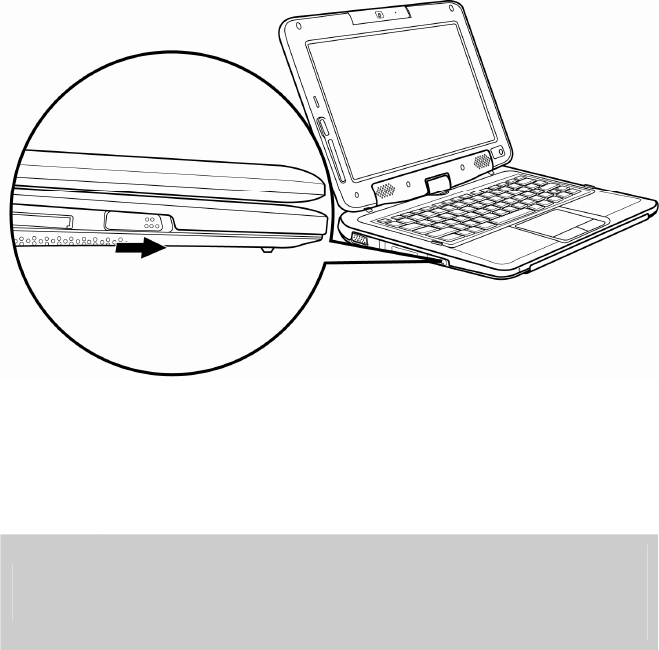
17
To switch the power on:
Slide the power latch towards you and release.
To switch the power off:
1. Make sure all applications are turned off.
2. Slide the power latch towards you and release.
A
Warning
• Never turn the notebook off during the POST, or an unrecoverable error
may occur.
• Never turn the notebook off while the hard disk is in use, or system data
may be lost or corrupted.
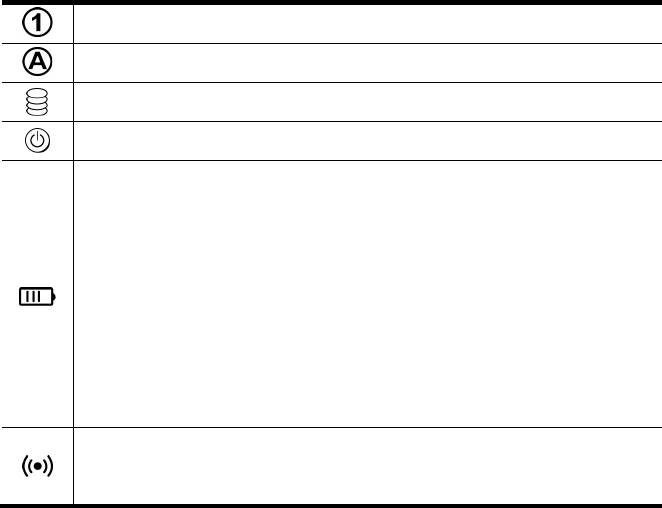
18
LED Status Indicators
The notebook has LED status indicators on the top of the LCD panel and to the
left of the LCD display, allowing you to see the system and power status of your
notebook at a glance.
Green light indicates the numeric keypad is activated.
Green light indicates the caps-lock is activated.
Green light indicates the system is reading/writing data.
Green light indicates the system is on.
Green light indicates the battery is fully charged and the AC adapter
is plugged in.
Orange light indicates the battery is charging.
Blinking orange light indicates the battery power is low.
No light indicates the battery pack is not installed in your system.
Green light → off → orange light → off → green light indicates the
battery temperature is too high.
Blinking green light indicates WLAN operation in progress.
Green light indicates the WLAN is on.
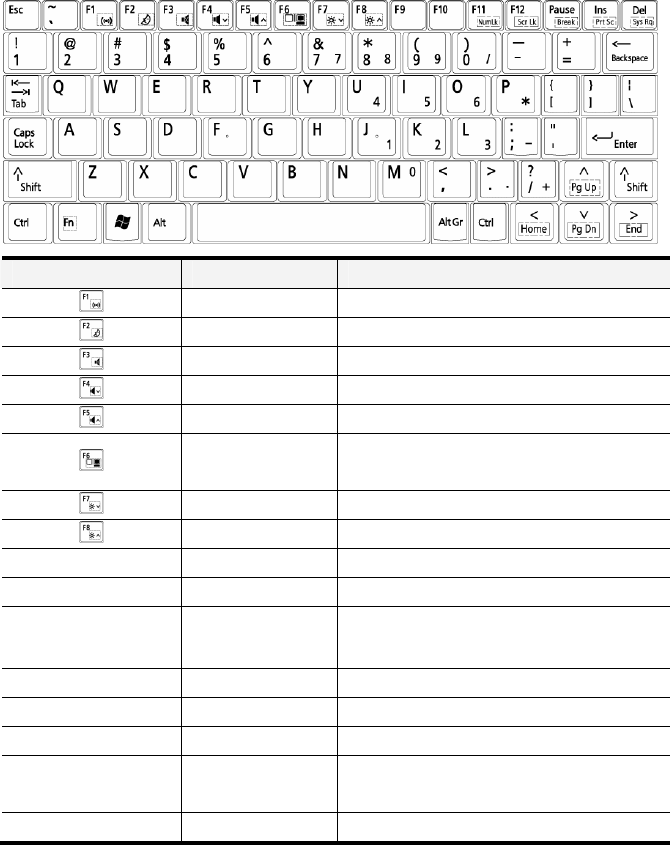
19
U
Us
si
in
ng
g
t
th
he
e
N
No
ot
te
eb
bo
oo
ok
k
Using the Keyboard
You can use certain key combinations to quickly configure system settings.
Graphic symbol Action System control
Fn + F1 Turn the WLAN module off or on.
Fn + F2 Enter the sleep mode.
Fn + F3 Turn off the volume output.
Fn + F4 Decrease the speaker volume.
Fn + F5 Increase the speaker volume.
Fn + F6 Switch the display between the LCD
panel and the external monitor.
Fn + F7 Decrease the brightness of the LCD.
Fn + F8 Increase the brightness of the LCD.
Fn + F11 Lock and unlock the number pad.
Fn + F12 Turn the scroll lock function on or off.
Fn + Ins (PrtSc) Capture the on screen display as a
graphic.
Fn + Del (SysRq) Call up the system run window.
Fn + ↑ (PgUp) Move to the previous page.
Fn + ↓ (PgDn) Move to the next page.
Fn + ← (Home) Move the cursor to the beginning of a
row.
Fn + → (End) Move the cursor to the end of a row.
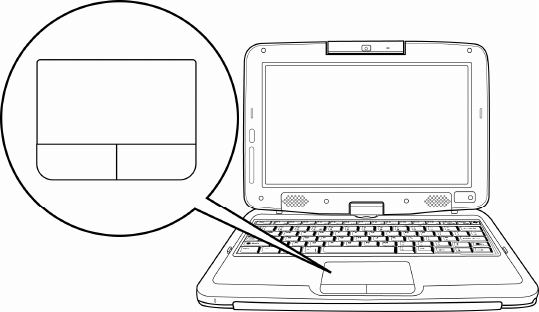
20
Using the Touch Pad
The touch pad includes a touch-sensitive pad and two buttons, and can be used
like a mouse. You can move the cursor on the screen, select items, and call up
menus.
• To move the cursor on the screen, move the tip of your finger across the
touch pad.
• To left-click, press the left button once.
• To double click, quickly press the left button twice.
• To right-click, press the right button once.
• To drag and drop, press and hold the left button, and move your finger on
the touch pad to the desired location.
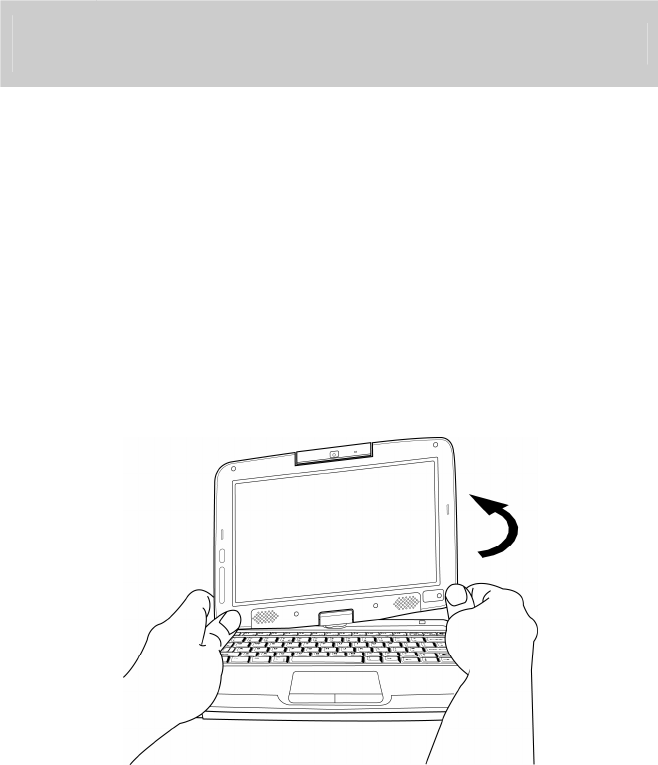
21
Using the Touch Screen
The display panel of your notebook also works as a touch screen. You can use
the stylus pen to control system operations, or as a pen for writing or
illustration applications. The first time you power on the notebook, follow the
on screen instructions to activate the touch screen.
A
Warning
Do not tap or write on the screen with excessive force. Doing so may damage
the LCD display.
Rotating the Display Panel
The display panel of your notebook can rotate up to 180 degrees. You can fold
it down with the display facing up, and use it as a writing pad. In the folded
position, the internal sensor intuitively switches the screen display to match the
orientation of the notebook. You can rotate the screen horizontally or vertically
to suit your needs.
To rotate the display panel:
1. Lightly grip the bottom corners of the display panel with your fingers, while
keeping your palms on the base of the notebook.
2. Gently turn in the counterclockwise direction.

22
3. Turn 180 degrees until the display panel gently snaps into place.
A
Warning
Do not try to turn the display panel in the opposite direction, or more than 180
degrees.
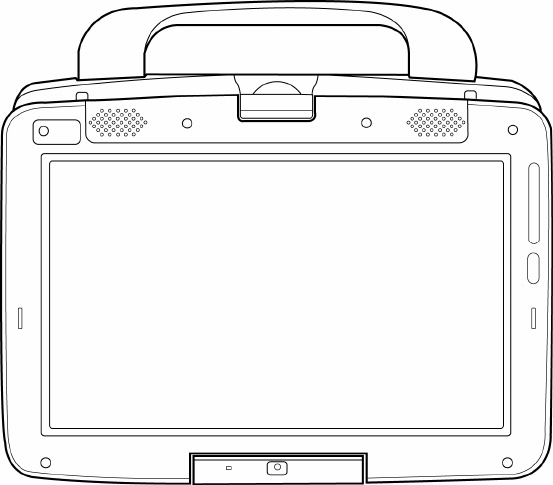
23
To use the display panel as a writing pad:
1. Make sure the display panel has been rotated 180 degrees.
2. Hold the display panel by one or both of the upper corners.
3. Gently lower the display panel to the closed position.
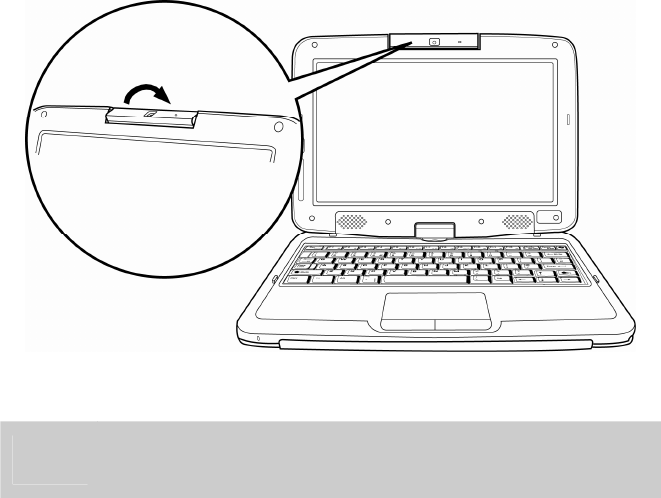
24
Using the Web Camera
The built-in web camera can rotate up to 180 degrees, and is equipped with an
internal sensor to automatically switch to the correct orientation. You can
rotate the web camera back and forth to use on both sides of the display panel.
To rotate the web camera:
1. Hold the edge of the web camera with your thumb and index finger.
2. Use your thumb to push the bottom edge of the web camera up.
3. Gently turn outwards until it locks into the 180 degrees position.
Note
The web camera must be returned to its original position for the display panel
to close properly.

25
Conserving the Battery Power
You can use a combination of key controls to enter the sleep or hibernation
mode to conserve the battery power.
• In the sleep mode, hardware devices, such as the display panel and hard disk,
are turned off to conserve energy.
• In the hibernation mode, all system data are saved in the hard disk before
powering down. No power or very little power is drawn from the battery
module.
To enter the sleep mode:
Press and hold [Fn + F2].
To enter the hibernation mode in Windows:
1. Press the Windows logo key, and then press [U].
2. When the popup window appears, press and hold [Shift + H].
To exit the sleep or hibernation mode:
Slide the power latch towards you and release.
Note
When exiting the hibernation mode, the amount of time the system requires to
restore all its previous contents can range from five to twenty minutes,
depending on how much RAM has been installed on your notebook.
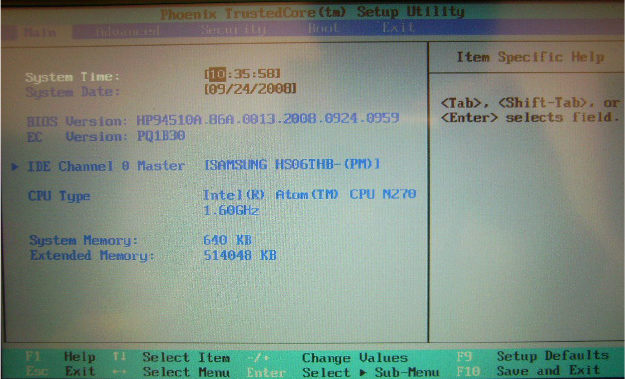
26
B
BI
IO
OS
S
S
Se
et
tu
up
p
The BIOS (Basic Input/Output System) Setup Utility runs and maintains a variety
of hardware functions. It is a menu-driven software, which allows you to easily
configure and change the settings. When turning on the notebook for the first
time, you may get a message prompting you to run the BIOS Setup Utility.
Entering BIOS Setup
Turn on the power, and press the DEL key quickly when the POST (Power-On
Self Test) is running.
Main Setup
In this menu you can change the time and date, and view basic processor and
system memory information.
• System Time: Enter the time in HH:MM:SS format.
• System Date: Enter the date in MM/DD/YY format.
• BIOS Version: Displays the BIOS revision number.
• EC Version: Displays the EC revision number.
• IDE Channel 0 Master: Displays the hard disk information. Use the items
in this menu to configure settings for your hard disk.
• CPU Type: Displays the CPU type.
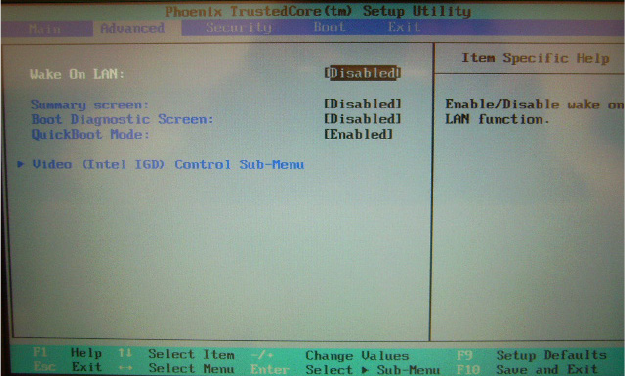
27
• System Memory: Displays the amount of conventional memory detected
during boot.
• Extended Memory: Displays the amount of extended memory detected
during boot.
Advanced Setup
In this menu you can configure advanced settings.
• Wake On LAN: When enabled, turning on wireless LAN will cause the
system to exit the sleep or hibernation mode.
• Summary screen: When enabled, system configuration is displayed during
boot.
• Boot Diagnostic Screen: When enabled, the diagnostic screen is displayed
during boot.
• QuickBoot Mode: When enabled, the system skips certain tests during
boot. This will decrease the time needed to boot the system.
• Video (Intel IGD) Control Sub-Menu: Use the items in this menu to
control the configuration of the Internal Graphics Display device.
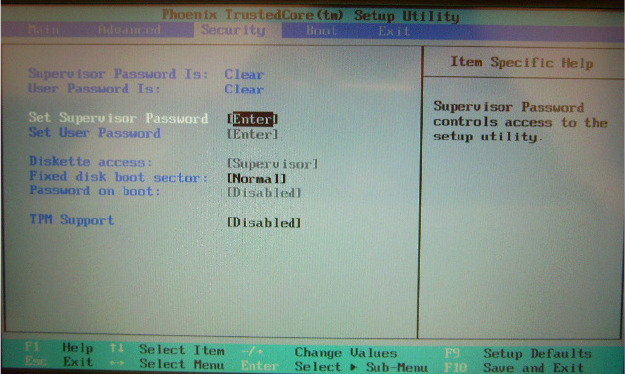
28
Security Setup
In this menu you can set up supervisor and user passwords to protect system
information and limit third party access.
• Supervisor Password Is: Displays the supervisor password.
• User Password Is: Displays the user password.
• Set Supervisor Password: Enter and confirm your new password. You
will be asked to enter this password each time you enter the setup utility.
• Set User Password: The supervisor password must be set before you can
set the user password. You will be asked to enter this password each time
the notebook is powered on.
• Diskette access: Configure user access for the BIOS Setup Utility.
• Fixed disk boot sector: Write Protect the boot sector of the hard disk to
avoid infection by some virus types.
• Password on boot: When enabled, a password is required during system
boot. Either the supervisor or user password will be accepted.
• TPM Support: When enabled, the built-in TPM security chip is activated.
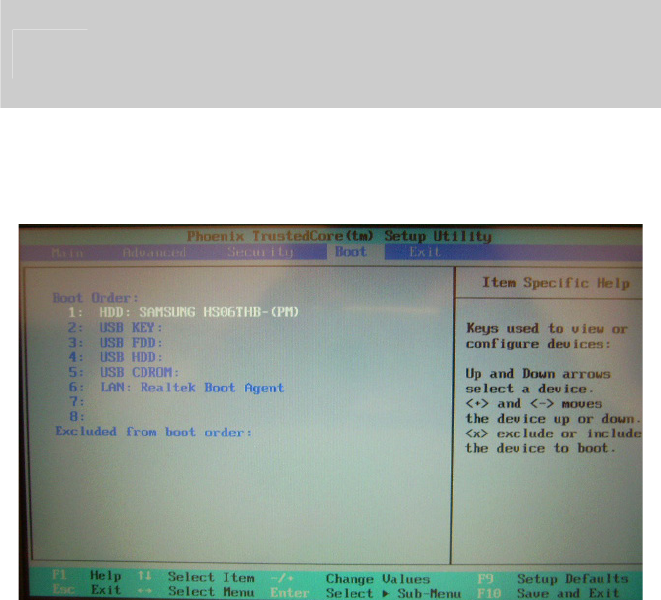
29
Note
• Passwords are not case sensitive.
• Write the passwords down and keep in a safe location. If you forget the
passwords, the notebook may need to be sent back to the factory or to an
authorized service dealer to reset the passwords.
Boot Setup
In this menu you can decide the order of boot devices to load the operating
system.
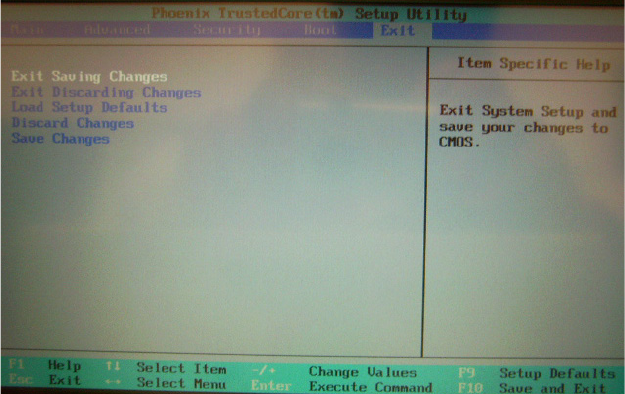
30
Exit Setup
• Exit Saving Changes: Exit system setup and save your changes to CMOS.
• Exit Discarding Changes: Exit system setup without saving changes to
CMOS.
• Load Setup Defaults: Load default values for all setup items.
• Discard Changes: Load previous values from CMOS for all setup items.
• Save Changes: Save setup data to CMOS.
31
T
Tr
ro
ou
ub
bl
le
es
sh
ho
oo
ot
ti
in
ng
g
Troubleshooting activity should only be performed by an adult.
Your notebook has been fully tested and complies with the system specifications
before shipping. However, incorrect operations and/or mishandling may cause
problems. You may also encounter simple setup or operating problems that can
be solved by considering the following suggestions. If the problem persists,
contact your dealer for service.
• Make sure the AC adapter is properly plugged into the notebook and a wall
outlet.
• Check to see if the power indicator of the notebook is on.
• Check to see if your keyboard is operational by pressing and holding any key.
• Make sure all devices connected to the external ports are plugged in
properly. You can also remove these devices to eliminate them as the source
of the problem.
• Some software programs may cause problems during your routine use.
Consult the software vendor for problem solving.
• An incorrect setting in the BIOS Setup Utility may cause the system to
malfunction. If you are unsure of the changes you made, go to the BIOS
Setup Utility and load default settings.
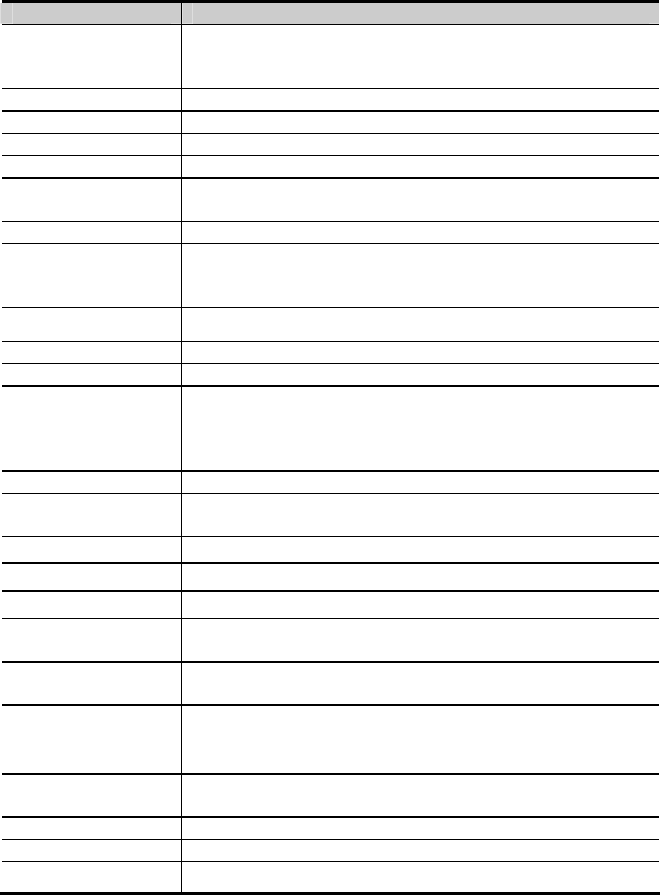
32
S
Sp
pe
ec
ci
if
fi
ic
ca
at
ti
io
on
ns
s
Items Prototype
Dimensions
(W x D x H)
w/o handle: 241.4 mm x 181.4 mm x 27.7 mm (front side)
with handle: 241.4 mm x 209.3 mm x 27.7 mm (front side)
ps. All of dimensions with tolerance 0.4 mm
Weight Target 1.21 kg
CPU Diamondville 1.6GHz, 512 KB L2 cache, FSB=533 MHz
Core Logic Intel 945GSE + ICH7-M
System Memory DDR2, 512MB / 1GB / 2GB
System Storage Option 1: NAND flash 4 / 8 /16 GB
Option 2: 1.8”HDD 60 GB
Boot ROM Phoenix code, 1MB flash ROM
LCD
8.9”-wide TFT LCD
Color mode: 1024x600, with LED backlit,
LVDS interface
Touch screen 5-wire 8.9’’ ITO resistive touch screen
Graphics Embedded in Intel 945GSE
Graphics Memory Share system memory
I/O ports
USBx2,
Headphone out, Mic-in, DC-in
RJ-45
VGA-Out
Audio HD audio codec, ALC269.
Audio I/O Headphone out, Mic-in, Internal mono MIC, Internal stereo
speakers
Wireless WLAN 802.11 b/g/n with mesh support
LAN Built-in Ethernet
Card Reader SD/MMC Card
Webcam
(optional) Integrated 1.3M Pixel Camera
Embedded
controller ENE KB3310D (w/KBC)
Battery
4 cell Li-Ion, 18650x4 (4400/4800mA, 7.4V)
6 cell Li-Ion, 18650x6 (6600/7200mA, 7.4V)
Removable battery pack with hard pack, gauge and connector
Buttons/Switches Lid switch (magnetic switch)
System On/Off button
Status indicators TBD.
Keyboard 80keys, Travel: 1.5mm +-0.2mm, Keyforce: 60+-15g
Touch pad Standard finger-sensing pad with two buttons
33
I
In
nd
de
ex
x
A
AC adapter
replacing, 5
B
battery
charging time, 15
installing, 14
removing, 15
status indicators,
15, 18
bezel button, 9
BIOS
configuration, 26
C
care and
maintenance, 2
E
external monitor
connecting, 10
F
factory settings
restoring, 30
H
headphones, 11
K
keyboard
controls, 19
L
LCD display
opening, 16
rotating, 21
M
memory card
inserting, 10
microphone, 9, 11
P
password
setting up, 28
S
switching the power
on and off, 16
system
settings, 26
status indicators,
18
T
touch pad, 20
touch screen, 21
stylus pen, 11, 21
using as writing
pad, 23
U
USB
connecting, 10, 11
W
web camera
rotating, 24